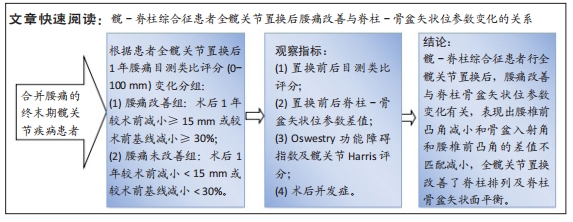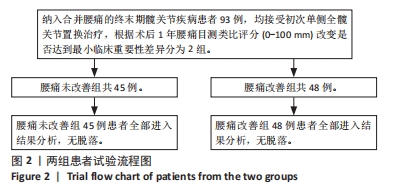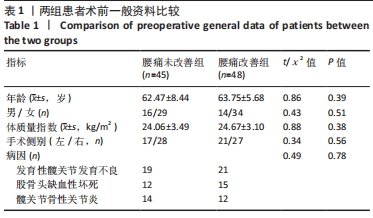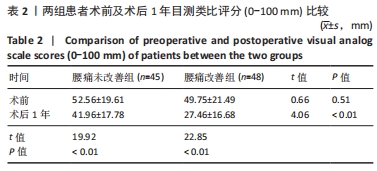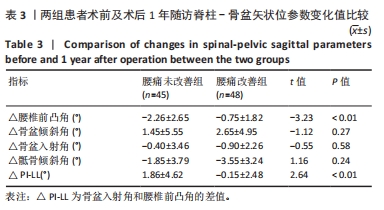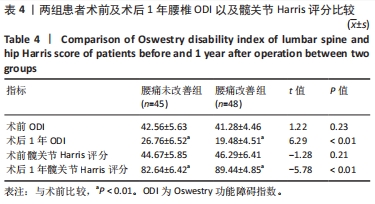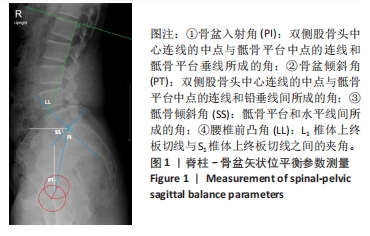[1] OFFIERSKI CM, MACNAB I. Hip-spine syndrome. Spine (Phila Pa 1976). 1983;3:316-321.
[2] ZAGRA L, BENAZZO F, DALLARI D, et al. Current concepts in hip-spine relationships: making them practical for total hip arthroplasty. EFORT Open Rev. 2022;7(1):59-69.
[3] TANAKA S, MATSUMOTO S, FUJII K, et al. Factors related to low back pain in patients with hip osteoarthritis. J Back Musculoskelet Rehabil. 2015;28(2):409-414.
[4] RIVIÈRE C, LAZIC S, DAGNEAUX L, et al. Spine-hip relations in patients with hip osteoarthritis. EFORT Open Rev. 2018;2:39-44.
[5] HSIEH PH, CHANG Y, CHEN DW, et al. Pain distribution and response to total hip arthroplasty: a prospective observational study in 113 patients with end-stage hip disease. J Orthop Sci. 2012;17(3):213-218.
[6] CHIMENTI PC, DRINKWATER CJ, LI W, et al. Factors Associated With Early Improvement in Low Back Pain After Total Hip Arthroplasty: A Multi-Center Prospective Cohort Analyses. J Arthroplasty. 2016;31(1):176-179.
[7] ENEQVIST T, NEMES S, BRISBY H, et al. Lumbar surgery prior to total hip arthroplasty is associated with worse patient-reported outcomes. Bone Joint J. 2017;99-B(6):759-765.
[8] STAIBANO P, WINEMAKER M, PETRUCCELLI D, et al. Total Joint Arthroplasty and Preoperative Low Back Pain. J Arthroplasty. 2014;29(5):867-871.
[9] VIGDORCHIK JM, SHAFI KA, KOLIN DA, et al. Does Low Back Pain Improve Following Total Hip Arthroplasty? J Arthroplasty. 2022;37(8):S937-S940.
[10] OKUZU Y, GOTO K, KURODA Y, et al. Preoperative Factors Associated With Low Back Pain Improvement After Total Hip Arthroplasty in a Japanese Population. J Arthroplasty. 2022;37(1):69-74.
[11] PIAZZOLLA A, SOLARINO G, BIZZOCA D, et al. Spinopelvic parameter changes and low back pain improvement due to femoral neck anteversion in patients with severe unilateral primary hip osteoarthritis undergoing total hip replacement. Eur Spine J. 2018;27(1):125-134.
[12] CHA E, PARK JH. Spinopelvic Alignment as a Risk Factor for Poor Balance Function in Low Back Pain Patients. Global Spine J. 2023;13(8):2193-2200.
[13] POURAHMADI M, SAHEBALAM M, DOMMERHOLT J, et al. Spinopelvic alignment and low back pain after total hip arthroplasty: a scoping review. BMC Musculoskelet Disord. 2022;1:250
[14] NAGATANI S, DEMURA S, KATO S, et al. Risk Factors for Progressive Spinal Sagittal Imbalance in the Short-Term Course after Total Hip Arthroplasty: A 3 Year Follow-Up Study of Female Patients. J Clin Med. 2022;11(17):5179.
[15] HAFFER H, WANG Z, HU Z, et al. Does Total Hip Arthroplasty Affect Spinopelvic and Spinal Alignment? A Prospective Observational Investigation. Clin Spine Surg. 2022; 35(8):E627-E635.
[16] KIM Y, POUR AE, LAZENNEC JY. How do global sagittal alignment and posture change after total hip arthroplasty? Int Orthop. 2020;2:267-273.
[17] OSTELO RWJG, DEYO RA, STRATFORD P, et al. Interpreting change scores for pain and functional status in low back pain: towards international consensus regarding minimal important change. Spine. 2008;33(1):90-94.
[18] CHALÉAT-VALAYER E, MAC-THIONG JM, PAQUET J, et al. Sagittal spino-pelvic alignment in chronic low back pain. Eur Spine J. 2011;20(S5):634-640.
[19] ROUSSOULY P, PINHEIRO-FRANCO JL. Biomechanical analysis of the spino-pelvic organization and adaptation in pathology. Eur Spine J. 2011;20(S5):609-618.
[20] HIRA K, NAGATA K, HASHIZUME H, et al. Relationship of sagittal spinal alignment with low back pain and physical performance in the general population. Sci Rep. 2021; 11(1):20604.
[21] 马明阳,刘宇博,杨敏之,等.单侧CroweⅣ型发育性髋关节发育不良患者人工全髋关节置换术后下腰痛及脊柱矢状位参数变化研究[J].中国修复重建外科杂志, 2021,35(12):1543-1548.
[22] MUELLNER M, WANG Z, HU Z, et al. Hip replacement improves lumbar flexibility and intervertebral disc height — a prospective observational investigation with standing and sitting assessment of patients undergoing total hip arthroplasty. Int Orthop. 2022; 46(10):2195-2203.
[23] ROUSSOULY P, LABELLE H, ROUISSI J, et al. Pre- and post-operative sagittal balance in idiopathic scoliosis: a comparison over the ages of two cohorts of 132 adolescents and 52 adults. Eur Spine J. 2013;22(S2):203-215.
[24] BLONDEL B, SCHWAB F, BESS S, et al. Posterior global malalignment after osteotomy for sagittal plane deformity: it happens and here is why. Spine. 2013;38(7):E394-E401.
[25] ESPOSITO C I, CARROLL K M, SCULCO P K, et al. Total Hip Arthroplasty Patients With Fixed Spinopelvic Alignment Are at Higher Risk of Hip Dislocation. J Arthroplasty. 2018; 33(5):1449-1454.
[26] WENG W, WU H, WU M, et al. The effect of total hip arthroplasty on sagittal spinal-pelvic-leg alignment and low back pain in patients with severe hip osteoarthritis. Eur Spine J. 2016;25(11):3608-3614.
[27] JAIN D, VIGDORCHIK J M, ABOTSI E, et al. The Impact of Global Spinal Alignment on Standing Spinopelvic Alignment Change After Total Hip Arthroplasty. Global Spine J. 2023;13(5):1252-1256.
[28] CHUN SW, LIM CY, KIM K, et al. The relationships between low back pain and lumbar lordosis: a systematic review and meta-analysis. Spine J. 2017;17(8):1180-1191.
[29] UEHARA M, IKEGAMI S, HORIUCHI H, et al. Prevalence and Related Factors of Low Back Pain in the General Elderly Population: A Japanese Cross-Sectional Study Randomly Sampled from a Basic Resident Registry. J Clin Med. 2021;10(18):4213.
[30] SCHWAB F, UNGAR B, BLONDEL B, et al. Scoliosis Research Society-Schwab adult spinal deformity classification: a validation study. Spine. 2012;37(12):1077-1082.
[31] TERAGUCHI M, HASHIZUME H, ASAI Y, et al. Association between modic changes, disc degeneration, and pelvic incidence–lumbar lordosis mismatch in a large population based cohort: the Wakayama spine study. Eur Spine J. 2023. doi: 10.1007/s00586-023-07702-8.
|
